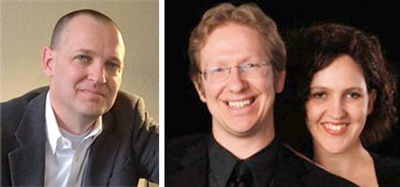by Daniel Hathaway

On the weekend of April 7-8, the Festival will focus on the theme of how Bach’s music inspired Johannes Brahms, and the featured choral work will be the German Requiem. Pianists Pierre and Sophié van der Westhuizen, who perform as the Westhuizen Duo, will also play a central role in this year’s Festival.
In a conference call with Festival director Dirk Garner and Pierre van der Westhuizen, Garner was quick to assure Bach Festival regulars that this year’s departure from the norm is a special case. “We’ll get back on cycle next year with the St. John Passion, because Bach’s major choral works are the most beautiful aspect of our annual event. But the Riemenschneiders, who founded the Festival, knew that neglecting the music of later composers would do a great disservice to Bach — both to his art and his legacy.”
Garner said that in addition to the Saturday evening German Requiem performance, the weekend will include smaller events where audiences will hear Brahms and Bach played back to back — and not even in complete works. “You’ll hear, for instance, 30 bars of Brahms and 30 bars of Bach juxtaposed and smashed together to let your ear make its own associations and connections. The Friday night concert is all Bach. We’re including the third Brandenburg Concerto, a motet and two movements from Cantata 21, which Brahms conducted, as well as keyboard works that he played and transcribed. It’s a really interesting snapshot of what music made an impression on him.”
The catalyst for exploring the Bach-Brahms connection came from BW Conservatory dean Susan Van Vorst, who initiated a conversation with Garner and Westhuizen over coffee last August. That evolved into inviting the Westhuizen Duo to play the Bach Double Clavier Concerto, BWV 1060, as the closer to the Friday evening concert, and to curate and play their own concert on Saturday afternoon.
“I just love these collaborations,” Westhuizen said. “We had such a wonderful time at BW with the Cleveland International Piano Competition Youth Competition that we wanted to expand the relationship. When you start thinking about the idea of Bach-inspired works, the sky’s the limit. If it weren’t for Brahms — and Mendelssohn — we wouldn’t know much about Bach today. Brahms was obsessed with his music.”
Westhuizen said that the Saturday afternoon program will explore Bach’s influences on later composers and arrangers both on the macro and micro level. “We’ll begin with Greg Anderson’s transcriptions of movements from the Matthew Passion. Anderson, who is one-half of the piano duo Anderson and Rowe, is a wonderful colorist.”
Bach’s influence on Dmitri Shostakovich’s Concertino will be clear to listeners.
“It begins with a French Overture and features so much dialogue and counterpoint. Its whole form is straight out of a Bach Orchestral Suite,” Westhuizen said.
That program will continue with transcriptions of the Bourée from Bach’s second French Suite by Leo Portnoff, and an arrangement of “Sheep May Safely Graze” by Victor Babin. The Westhuizens will close with Brahms’s Variations on a Theme by Haydn. “It ends with a big fugue and a chaconne — a gesture that would have been impossible without the influence of Bach,” the pianist said.
On Saturday evening, when Octavio Más-Arocas conducts the German Requiem, he’ll have the benefit of having studied Brahms’s own rehearsal markings in a score owned by the Riemenschneider Bach Institute at BW. Garner examined that score long before joining the BW faculty — when he was 22 and still a graduate student at the Cincinnati College-Conservatory.
“My teacher mentioned that score, so I hopped in a car with my buddies and drove up to Cleveland to take a look. I wrote Brahms’s markings into my own score — and the new Carus edition of the Requiem score also incorporates them. He added lots of dynamic markings that he obviously heard when he was actually rehearsing the piece. They’re sort of scrawled in during the heat of battle.” Festival attendees can view the score during certain hours this weekend.
The 85th Bach Festival will include familiar components: two lectures, outdoor brass music, and a Saturday morning run which attracted 70 participants last year, but Garner has added a couple of new wrinkles to the schedule in 2017. One is an informal piano hour in the Gamble Auditorium Lobby before the Saturday evening Requiem performance — a program of Bach-Brahms “lounge music” played by Zarina Melik-Stepanova.
Another Garner invention is “BYOB” or “Bring your own Bach” on Saturday afternoon in Kulas Hall, when musicians of all varieties are encouraged to bring a short Bach piece along and sing or play it in public. “Every year I meet a patron who tells me something like, ‘I was in the Festival in 1954.’ During my first year, I met a woman who sang in Bach Festival No. 2 — 82 years before,” Garner said. “Probably some of them still play an instrument or sing. I want those audience members to walk in with their flute, or oboe, or their aria or their piano prelude, and feel comfortable and excited to share music in a non-threatening, supportive environment, just for the love of making this music together. They may worry about not being perfect or polished, but that’s not the only world that music should live in.”
Click here for a complete Baldwin Wallace Bach Festival schedule and ticket information.
Published on ClevelandClassical.com April 4, 2017.
Click here for a printable copy of this article



